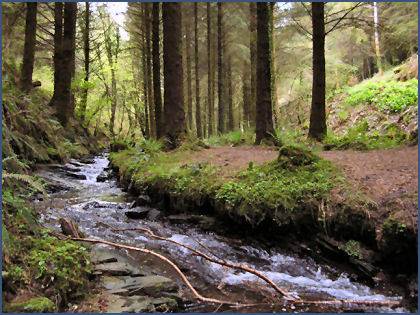Cardinham
OS Grid ref:- SX1268
 The small village of Cardinham is siuated on the southern edge of Bodmin Moor. Known in Cornish as Kardhinan, the name derives from the Cornish word 'Car', or 'Caer, which translates as fort and 'Dinas' also meaning fortress.
The small village of Cardinham is siuated on the southern edge of Bodmin Moor. Known in Cornish as Kardhinan, the name derives from the Cornish word 'Car', or 'Caer, which translates as fort and 'Dinas' also meaning fortress.
The earthwork remains of Cardinham Castle are situated on high ground to the south of the church (OS grid ref:-SX126680). The castle is believed to have been built by the Norman Richard Fitz Turold, who was Sheriff of Cornwall for Robert, Count of Mortain, half brother to William the Conqueror.
Earl Robert, not being content with the vast estates he already been granted following the Norman Conquest of 1066, also seized much of the land in the parish of Cardinham, which had previously belonged to the priory in Bodmin. His actions were very unpoplular with the locals and he reacted by building the fortress to keep the local people in subjection.
The motte stands at four metres high and has been extensively damaged on its top and eastern side. The bailey is generally well preserved on the west and south sides but the east side has been cut away. The site has been described as a timber castle, the majority of castles in the immediate post conquest period took this form. The castle stands on privately owned land and the permission of the landowner must be sought before visiting.
Cardinham Woods, which lie at the end of the lovely Glynn Valley, are owned by the Forestry Commision. Consisting of highly attractive mixed woodland, the area is popular with cyclists, walkers, and horse riders. There are four waymarked trails and miles of other tracks and paths to explore which weave their way through 650 acres of woodland. Wildlife includes deer, buzzard, otter and kingfisher. Refreshments are avaiable at Woods Café.
On nearby St Bellarmin's Tor stand the remains of a small chapel dedicated to St Bartholomew who is said to have lived and preached there. Pinsla Garden and Nursery is an artist's garden set in picturersque Cornish woodland. Situated at Glynn near Cardinham, Pinsla has naturalistic planting and imaginative landscaping, the highly attractive garden covers 1˝ acres and is well worth a visit.
The Church of St.Meubred
 The handsome Parish Church of Cardinham was dedicated in 1085 to St Meubred the Martyr, a fifth to sixth century Irish missionary who was beheaded in Rome and his body returned for burial to the church.
The handsome Parish Church of Cardinham was dedicated in 1085 to St Meubred the Martyr, a fifth to sixth century Irish missionary who was beheaded in Rome and his body returned for burial to the church.
The present granite building dates to the fifteenth century, and has superb wagon roofs and a Green man roof boss. Only the font, which dates to the Norman era, the Easter sepulchre or Meubred’s tomb and various stones remain of the previous buildings that occupied the site, the elaborate bench ends (pictured left), of which there are 71, date to the fifteenth and sixteenth centuries. The bench ends include the arms of the Glynn family, a five pronged eel spear.
The church also contains a letter from King Charles I to loyal parishes painted on boards, one of best plaster Royal coats of arms in Cornwall dating to 1661 and an early brass of Thomas Awmarle , a priest, which dates to circa 1400. Awmarle is depicted in civilian dress with a sword. In the south east corner of the south aisle is a large monument to the Glynn family dated 1699.
In the churchyard stand two superb Celtic crosses, one of which stands over eight feet in height, dating back to the eighth century, it has been described as one of the best in Cornwall. The other is believed to date to the tenth or eleventh centuries.
The church was damaged by German bombs which were probably intended for Bodmin during the Second World War.